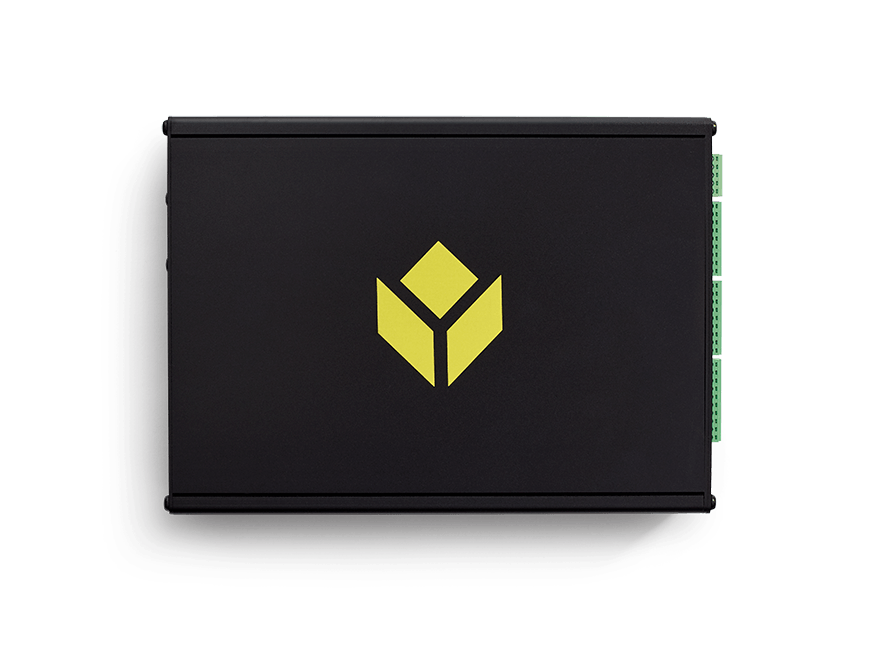Tulip I/O Gateway Technical Specifications
Here are all the technical details of the Tulip I/O Gateway.
I/O Gateway Notice
On November 1, 2021, Tulip will no longer sell I/O Gateway devices. Edge IO and Edge MC Devices are still available. Learn More

Voltage supply, Current Consumption, and Conditioning
- Nominal supply: 24V (Vin_min: 12V Vin_max: 30V)
- Nominal supply current: 250mA (depends on number of USB devices connected)
- Nominal power consumption: 6W
- Undervoltage Lockout: 11.5V
- Overvoltage Lockout: 30.5V
Features
- Reverse polarity protection
- Overcurrent protection
- Miswire and reverse current protection
- Surge protection
Usage
- Use either a Tulip provided Factory Kit power supply or a regulated 24V input
Grounding and Earth Connections
- Chassis (including the DIN mount) and 24V Return are internally connected
- Optionally, pin 2 of the supplied 3-terminal power connector can be referenced to earth
- Input banks A and B on the Gateway feature an additional grounding pin reference to the 24V return for convenience
Recommendations
- In production, DIN rail should be held at earth potential.
- Optionally, pin 2 of the supplied 3-terminal power connector can be referenced to earth.
User I/O
- Two user buttons A and B can be used for device resets
- Hold Buttons A and B for 5 seconds to perform a factory reset
- Hold Button A for 5 seconds to enable the Tulip Access Point
- Hold Button B for 5 seconds after a plug cycle to auto-enable Tulip remote support
- One reset button (resets CPU)
- Heartbeat/Alert LED for device diagnostics
Temperature Range (Operating / Storage)
- 0 - 75 ℃
Humidity
- 5% - 80% rel hum. non-condensing
Processor
- TI Sitara ARM Cortex (AM3358)
- 512M DDR3 Memory
- 4GB eMMC storage
OS/Software
- Tulip OS (Yocto-Linux based)
- Nominal I/O Gateway to Factory Bandwidth: 10Hz
- Nominal I/O Gateway Bandwidth: 240Hz
- Tulip-managed OTA Updates (Requires port 9000 to be open to traffic)
- Contact Tulip to discuss integration of additional Kernel drivers or run-time drivers.
Tulip OS Driver Support
- To see a list of supported devices in Tulip visit www.tulip.co
Digital Input
- 16 Digital PNP/NPN configurable inputs (Nominal configuration: PNP)
- Pins 1-8 in bank A
- Pins 9-16 in bank B
- Wide input range (1.8V - 36V)
- Digital input ground is connected to device 24V return
- IC: MCP23017
Digital Output
- 8 500mA 24V output drivers
- Individual channel over-temperature and over-current protection
- Drives relays and other inductive loads safely
- IC: VN808
Analog to Digital
- 4 Linearly isolated 0-10V inputs (Vadc-in_min = 0V, Vadc-in_max = 24V)
- 10-bit effective resolution
- Bandwidth (nominal): 240Hz
- IC: ADS1015
- Contact Tulip to discuss 4-20mA ADC input or differential ADC configurations.
RS-232 Port
- 1 RS-232 port using RX and TX lines
- IC: ADM3251
- Support for additional physical interfaces (RS-485, RS-422) is possible; contact Tulip
Ethernet
- Wired 10/100 Mbps Ethernet Port
I/O Recommendations
- In production environments requiring sensor/interface isolation, use a relay or other form of isolation to isolate the sensor and the input stage. Consult Tulip for additional information.
USB
- 6 USB 2.0 (High speed 480 Mbit/s) ports
- 500mA current sourcing per port
Mechanical
- 220mm x 160mm x 51mm (8.6 in x 6.5 in x 2 in)
- Weight: 2.2Kg (4.9 lbs)
- Aluminum (Anodized)
- Mounting: User serviceable 35mm DIN mount (can be mounted vertically or horizontally)

